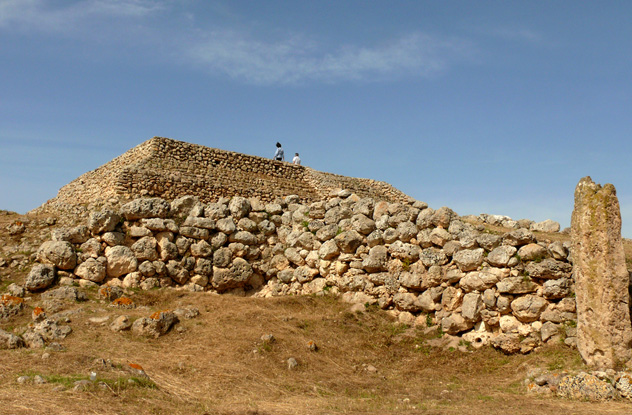 Weird Stuff
Weird Stuff  Weird Stuff
Weird Stuff  Animals
Animals 10 Inspiring Tales of Horses Being Human
 Mysteries
Mysteries Top 10 Haunting Facts About the Ghost Ship MV Alta
 History
History 10 Surprising Stories About the Texas Rangers
 Humans
Humans 10 Philosophers Who Were Driven Mad by Their Own Theories
 Miscellaneous
Miscellaneous 10 Video-Game-Worthy Weapons and Armors from History
 Weird Stuff
Weird Stuff 10 Psychics Who Accurately Predicted Wartime Events
 The Arts
The Arts 10 Pieces of Art Inspired by a Broken Heart
 Health
Health 10 Science Fiction-Sounding New Medical Treatments
 History
History 10 Surprising Facts About the Father of Submarine Warfare
 Weird Stuff
Weird Stuff 10 Times Real Laws Were Based on Bizarre Hypotheticals
 Animals
Animals 10 Inspiring Tales of Horses Being Human
 Mysteries
Mysteries Top 10 Haunting Facts About the Ghost Ship MV Alta
Who's Behind Listverse?

Jamie Frater
Head Editor
Jamie founded Listverse due to an insatiable desire to share fascinating, obscure, and bizarre facts. He has been a guest speaker on numerous national radio and television stations and is a five time published author.
More About Us History
History 10 Surprising Stories About the Texas Rangers
 Humans
Humans 10 Philosophers Who Were Driven Mad by Their Own Theories
 Miscellaneous
Miscellaneous 10 Video-Game-Worthy Weapons and Armors from History
 Weird Stuff
Weird Stuff 10 Psychics Who Accurately Predicted Wartime Events
 The Arts
The Arts 10 Pieces of Art Inspired by a Broken Heart
 Health
Health 10 Science Fiction-Sounding New Medical Treatments
 History
History 10 Surprising Facts About the Father of Submarine Warfare
10 Mysterious And Enthralling Buildings Older Than Stonehenge
For most people, Stonehenge stands as a symbol for the most ancient of civilizations, the work of humans who had barely emerged from their hunter-gatherer origins. Those people might well be surprised to know just how many mysterious buildings survive, in one form or another, from much earlier epochs—and in places few would even dare to look.
10White Temple Of Uruk
3200 BC
A long way from the quiet shires that house Stonehenge stands a building that is yet more ancient. Perched at the top of the oldest existing ziggurat, in what is modern-day Warka, Iraq, is the weather-worn White Temple. Less known than the complexes on the ziggurat at Ur, the White Temple is only 20 meters (60 ft) in length. The name, added in modern times, comes from its whitewashed, mud-brick walls, whose sides still stand sentinel over the sands of the long-gone Sumerian empire. What the original name for the temple was, no one knows, as the early history of the site is achingly difficult to piece together. Could this building have buried within it secrets relating to a truly ancient organized religion?
What makes the White Temple especially intriguing is its connections to Anu, the oldest god of the Sumerian pantheon (and one of the stars of the Epic of Gilgamesh). It is also fascinating for the treasures it may well have housed, including the Warka Vase. This 5,000-year-old artifact was once housed in the Iraqi National Museum in Baghdad, before being looted in April 2003. It was later returned in a dozen pieces, months later, a sad reflection of the fragile state of Iraq’s present and its ancient past.
9Tarxien Temples
3250 BC

The Tarxien Temples are set amid the built-up neighborhood of Paola, just half an hour from Valletta, the capital of Malta. Less well-known than the Ggantija Temples and nearby underground Hypogeum of Hal-Saflieni, these aboveground buildings are the most complex of all the ancient temple sites in Malta.
There are three temples at Tarxien, all different ages, with the oldest dating to 3250 BC. The mystery lies in the beliefs of the people who constructed them. Were they simply artistic structures, suggested by the intricate and beautiful animal carvings that can be seen there, or did they serve a Sun god? Perhaps they were a homage to an obese fertility goddess, whose corpulent figure crops up so often at the site.
The Tarxien temples were discovered accidentally by a farmer in 1913 and have since been carefully restored, though they are still open to the elements. A tent and flood protection have been proposed for the temples, but for the moment, they remain within view of the azure sky and the ever-staring Sun.
8Sechin Bajo Plaza
3500 BC

Everyone has heard of the legendary Inca Empire and their Machu Picchu citadel, but fewer know about the remains of Peruvian civilizations that are older—much older. Five thousand years before the Incas reached their peak in the 15th century, ancient groups in the New World were constructing Sechin Bajo. The site consists of a circular plaza 14 meters (45 ft) in diameter, 370 kilometers (230 mi) north of modern-day Lima.
Adobe friezes show a warrior holding a knife in one hand and what could be a head or a shield in the other. There are disputes over the age of the site, but carbon-dating techniques conducted by a German and Peruvian archaeological team in 2008 date the plaza to 3500 BC, making it the oldest building complex in the Western hemisphere.
Things get even more mysterious with the mention by the team of older plazas that might be buried beneath the main site. That mystery will have to be for another day, however, as the archaeologists await further grants to delve deeper. In the meantime, scientists are filling in the site with dirt to preserve it and protect it from tomb raiders.
7West Kennet Long Barrow
3650 BC

Seven hundred years before Stonehenge was being prepared, West Kennet Long Barrow was already built, just 25 kilometers (15 mi) from the famous stone circle. A barrow is a place to hold the dead, traditionally the social elite, and this barrow is one of the best preserved in Britain. It dominates the nearby area, at over 100 meters (330 ft) long and 12–24 meters (40–80 ft) wide, and it is tall enough inside to let a person stand upright. Dating from 3650 BC, it was in use for almost 1,000 years, holding the bones of 50 people.
Speculation abounds as to why the barrow was abandoned. Was it simple neglect or something more cryptic? Did a change in belief lead to a change in burial practice and a blocking up of the old barrows? Could it be something to do with the arrival of the Avebury stone circle, built around the time of the Long Barrow’s demise, just 2 kilometers (1.2 mi) away?
6Knap Of Howar
3700 BC

The two stone structures that form the Knap of Howar may at first appear insignificant, but they are in fact 5,700 years old and are the oldest known stone houses in northern Europe. The walls of these houses still stand over 1.6 meters tall but were only uncovered in the 1930s, after severe sea erosion and gales blew their cover.
The houses can be found at the northern tip of Scotland’s Orkney Islands, an archipelago of over 70 islands, of which 20 are inhabited. Together with the more famous sites of Orkney, such as Skara Brae and the Ring of Brogar, the Knap is part of the Heart of Neolithic Orkney UNESCO World Heritage Site. The name of the site comes from Old Norse and means “mound of mounds.”
Several curious questions linger over these prehistoric houses. What is the significance of the pottery shards and stone and flint tools found throughout the houses? Was the Knap a workshop, whose tools were traded far beyond the islands? The houses had spacious living quarters, and there are indications of yet older structures beneath. Just how ancient and advanced was the civilization that made such homes this far north?
5Monte D’Accoddi
4000 BC

If most people were asked where they could find a truly ancient pyramid, few would mention the northwestern coast of Sardinia, in the Mediterranean. But it is here that you would find Monte d’Accoddi, a 6,000-year-old building whose true purpose is still the subject of debate. With its earliest foundations going back to 4000–3650 BC, this site not only predates Stonehenge but is also more ancient than the oldest pyramids of Egypt, which arrive on the scene over 1,000 years later.
Scholars translate the name as “Stone Mount,” and the building consists of a ramp over 40 meters (130 ft) long, leading to a step-pyramid that would have been 8 meters (25 ft) tall. Uniquely, the nearby area also houses both a 4.44-meter (14.6 ft) upright menhir and a limestone sphere with a circumference of almost 5 meters (15 ft). Lonely Planet describes the site as “unlike anything else in the Mediterranean,” and for such a phenomenal place, surprisingly few tourists venture here.
Monte d’Accoddi has been defined alternatively as an altar, a ziggurat, a temple, and a pyramid. Only adding to the mystery is the “red room” at the center of the site, whose walls are smeared with red ochre. Despite repeated studies, there is no clear answer as to just what happened on this mysterious mount.
4Tumulus Of Bougon
4700 BC

The Tumulus of Bougon ranks as one of the world’s few remaining structures that would have been regarded as ancient even back in the time of Stonehenge. A tumulus is an artificial mound, usually one built over a grave site. The site at Bougon, in the Deux-Sevres department of France near the Atlantic coast, consists of no fewer than six tumuli.
The biggest is 72 meters (240 ft) long, and the tumuli vary in size and shape; some are circular, others rectangular or trapezoidal. Were these shape choices simply based on aesthetic tastes, or is there a deeper significance, perhaps related to the builders’ beliefs in the afterlife?
Other mysteries surround these 7,000-year-old buildings. A skull of a man was found inside, and it bears truly ancient evidence of trepanning. To trepan a skull meant to perforate a hole in it, with the presumed aim of curing mental disorders. Did the man survive his affliction, or was he hastily buried at Bougon? We might now regard those who carried out this procedure as mad, but we can now see just how timeworn a cure it was.
3Cairn Of Barnenez
4800 BC

A faceless portrait—repeated and mysterious U shapes—frantic zig-zags. All of these symbols etched out on stone slabs, inside vaults that have stood for over 68 centuries. These are some of the secrets that are sepulchered inside the Cairn of Barnenez, in northern Finistere, in the Brittany region of France.
The Cairn of Barnenez is not the grave site of one man but houses 11 different tombs, added one by one over centuries, starting in 4800 BC. This is such an ancient monument that as big a chasm of years separates the builders of this cairn from the writers of the Old Testament as separates those biblical authors from the 21st century.
This is no small site either. The cairn is 75 meters (250 ft) long and 25 meters (80 ft) across at its widest. The estimated weight of the stones that make up the site is 12,000 tons, making the cairn the biggest megalithic mausoleum in Europe.
2Tower Of Jericho
9000 BC

The Tower of Jericho marries mystery with biblical fame, beauty with fear, grandeur with power. The origins of the 8.5-meter (28 ft) stone tower, a staggering 11,000 years old, justify the tower being described as the world’s oldest skyscraper.
The tower marks a milestone in the history of human progress, standing tall before most human tribes had settled down into sedentary communities. Constructing the tower marked one of the first achievements of what could be called the urban human, who for tens of thousands of years previously had roamed the land without a fixed home.
The mystery lies in the tower’s purpose. Almost every year that has passed since it was discovered 65 years ago has provided a new theory for its function. The ideas span everything from the tower being a time-keeping device to constituting a flood-defense, from being a symbol of wealth to being a defensive territorial marker. Even how it was constructed remains to be deciphered. As a part of the biblical city of Jericho, whose walls were so famously to fall, the tower’s future as a monumental marker in human history is assured.
1Tell Abu Hureyra
11,000 BC

The rectangular walls of the houses of Tell Abu Hureyra truly have an epic story to tell—one with a final twist.
The story begins at the dawn of human agriculture, a remarkable chapter in the tale of Homo sapiens. Some of the earliest cultivated cereals are found among the jaw-droppingly old remains of Tell Abu Hureyra, in what is now northern Syria. The village has been radiocarbon-dated as being a mind-blowing 13,000 years old.
This may have been the first foray into full-blown farming, according to research led by Professor Hillman of University College London. “As the wild grasses and seeds that the people relied on for food died out,” said Hillman, “they were forced to start cultivating the most easily grown of them to survive.” We will never know for sure what inspired these earliest farmers to be the first to launch the human race into its latest epoch.
But what of the final twist? These ancient structures were deliberately flooded and now keep their secrets deep beneath the waters of Lake Assad.
Philip tutors in an inner-city London school and is set to have a viral educational video channel on YouTube, if only he can get round to posting more videos.








